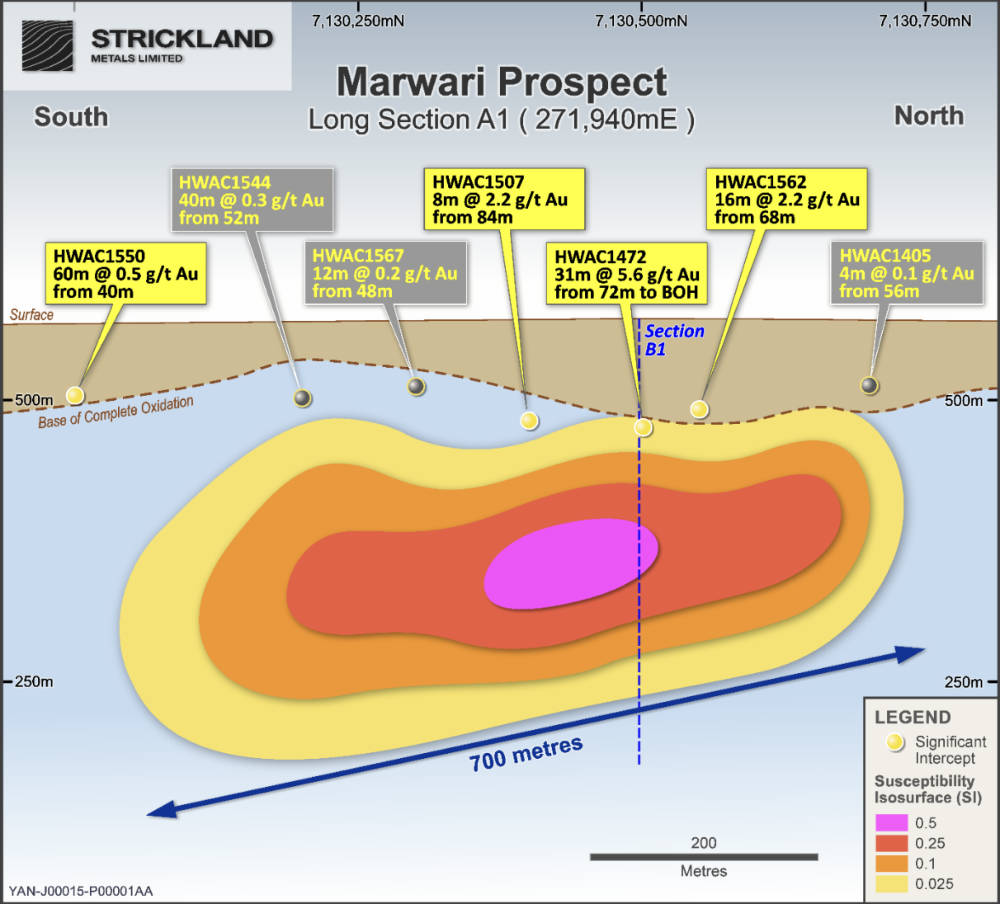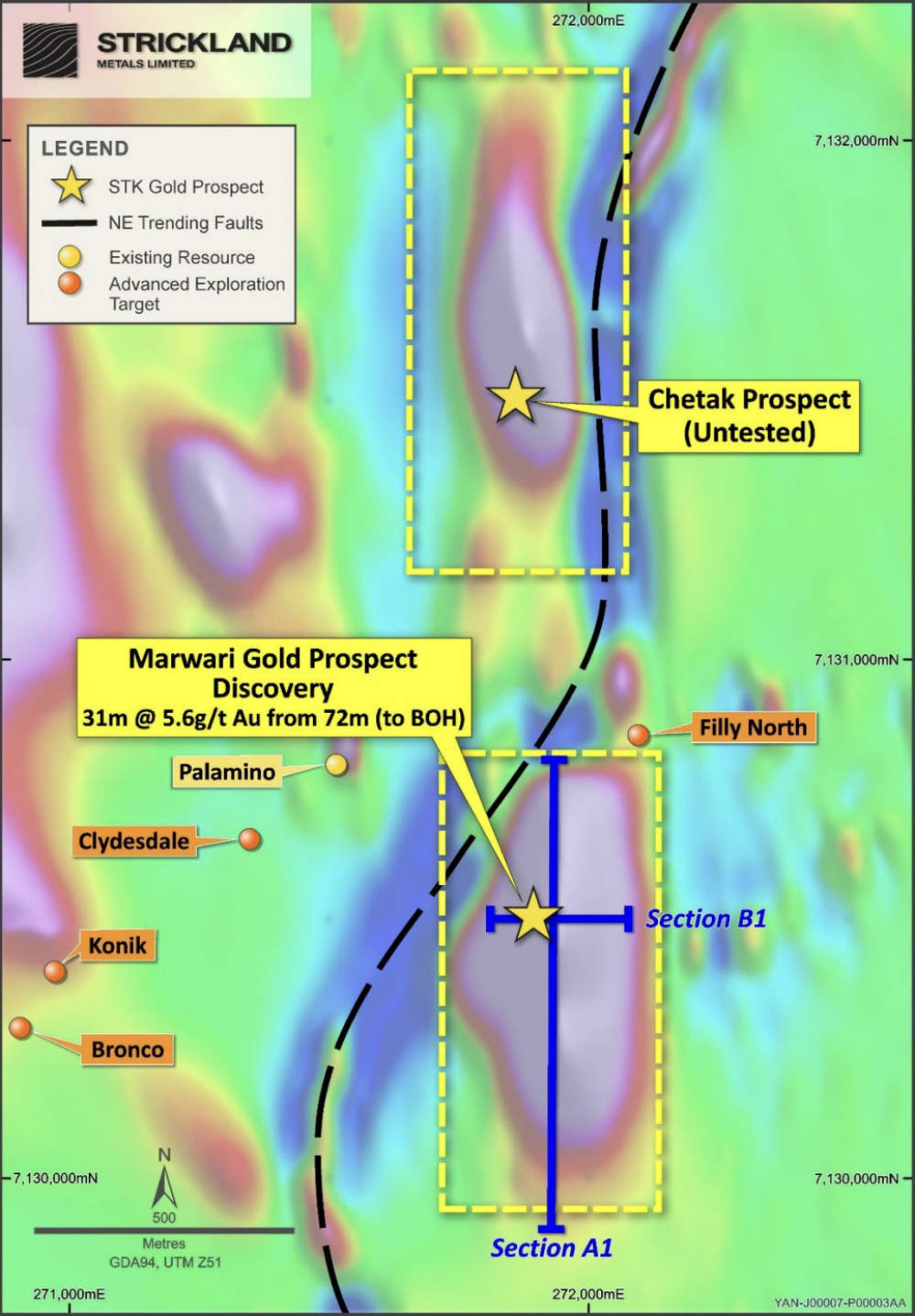Strickland has only just scratched the surface of the massive, high grade gold potential at Marwari

The real prize at Marwari will be tested by RC and diamond drilling. Pic: StevieS via Getty Images.
- Strickland confirms that Marwari discovery is a large gold target with a strike of over 700m
- Drilling and magnetic inversion modelling indicates that it has clipped the outer edge of a substantial, concealed gold deposit
- Magnetic inversion modelling also identified the Chetak look-a-like target immediately to the north
- RC and diamond drilling to begin in the coming weeks
Strickland’s aircore drilling has now mapped the exciting, high-grade Marwari gold discovery at the Horse Well project in WA’s Goldfields region over a prospective strike of 700m.
Strickland Metals’ (ASX:STK) ongoing 40km aircore drilling blitz was designed to systematically explore for gold in new areas – including the poorly understood Horse Well project – that it had acquired in July 2021 to consolidate the entire NE flank of the prolific Yandal Greenstone belt.
It quickly led to the discovery of Marwari in September.
Marwari first turned up in aircore hole HWAC1472, which returned a spectacular 31m intersection grading 5.6 grams per tonne (g/t) gold from a down-hole depth of 72m.
The trend was quickly intersected again in aircore drilling 100m and 250m to the south for an initial drilled strike length of 350m.
Ongoing drilling under the 50,000m aircore drilling (upgraded from an initial 40,000m), which started in August this year, quickly extended Marwari’s strike to 500m in late September.
While Marwari would be cause for celebration on its own, drilling quickly grew the Palomino prospect with a hit of 39m at 6.1g/t gold from 25m and intersected near-surface gold at the previously undrilled Konik area with assays such as 58m at 1.7g/t gold from 17m.
This spate of discoveries has sent shares in the company climbing some 93% to 8.5c since the beginning of September.
Adding further interest, reinterpretation of datasets has highlighted the 3km long Pegasus target, which dwarfs Marwari and Palomino. Meanwhile, heritage surveys to allow the potentially massive Great Western and Rabbit Well targets to be drill tested have been completed.

Marwari’s scale confirmed
A redesign of the aircore drill program to delineate the extent of mineralisation at Marwari has now mapped the prospect to over 700m of prospective strike.
Further supporting the belief that Marwari has significant scale behind it, 3D Magnetic inversion modelling has delineated a large, south plunging magnetic anomaly target immediately beneath the current aircore drilling.
Only the discovery hole HWAC1472 has tested any part of this anomaly – having intersected the margin of the outermost shell of the magnetic inversion – while other holes close to the anomaly have had a deeper weathering profile compared to aircore holes drilled to the south.
Proximal shallow aircore holes returned 16m at 2.3g/t gold and 8m at 2.2g/t gold, while the most distal holes returned 60m at 0.5g/t gold and 40m at 0.3g/t gold on a north-south axis.
This lends further support to the theory that the modelled magnetic anomaly is an alteration zone associated with the main gold mineralising event, making it a priority target for testing with reverse circulation and diamond drilling in the coming weeks.
Chief executive officer Andrew Bray said the combination of aircore holes drilled to the north and south of HWAC1472 to map mineralisation and geology as well as magnetic inversion modelling to assist with target definition suggests that the company has clipped the outer edge of a substantial, concealed gold deposit.
“The magnetic inversion model outlined a coherent and substantial target beneath the current aircore drilling, extending for ~700m strike with a gentle southerly plunge. This aligns perfectly with the aircore drilling results,” he said.
“The magnetic inversion modelling work also identified a second, look-a-like target immediately to the north, named Chetak, on the other side of a major NNE fault structure.
“This target has not yet been tested as part of the current aircore program, however it will be incorporated into the upcoming RC program. The combined strike length of these two targets is approximately 1.3km.”
He added that drilling at Marwari also intersected lateritic gold mineralisation at surface in a zone measuring 200m by 120 and with thicknesses ranging from 4m to 8m.
“This is a promising shallow target that, in a development scenario, will de-risk development of the depletion zone down to the saprolite and transition ore,” Bray said.
“This laterite gold mineralisation is orders of magnitude larger than anything seen within the wider Horse Well area to date.
“Overall, Marwari continues to shape up as a very promising and significant gold discovery and the company is eagerly looking forward to drilling the main structure over the coming weeks.”

RC and diamond drilling to start soon
Strickland, which is cashed up from the $61m sale of the Millrose deposit to Northern Star (ASX:NST), is now preparing to carry out both RC and diamond drilling.
The RC rig is scheduled to arrive next week, and a diamond rig will arrive the following week.
This will focus on drilling the Marwari, Great Western, Rabbit Well and Chetak prospects as well as follow up any additional anomalism at Konik or new discoveries on the Pegasus trend.
Aircore drilling is also continuing with the rig returning to undertaking systematic fence lines across the Horse Well area.
This is expected to drill a number of promising areas with similar geophysical characteristics to existing prospects and discoveries.
This article was developed in collaboration with Strickland Metals, a Stockhead advertiser at the time of publishing.
This article does not constitute financial product advice. You should consider obtaining independent advice before making any financial decisions.
Related Topics

UNLOCK INSIGHTS
Discover the untold stories of emerging ASX stocks.
Daily news and expert analysis, it's free to subscribe.
By proceeding, you confirm you understand that we handle personal information in accordance with our Privacy Policy.








